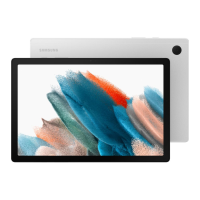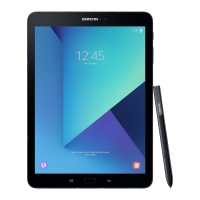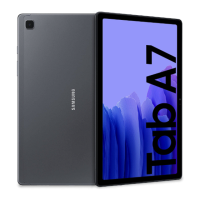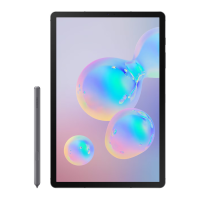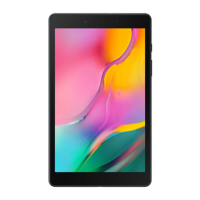Do you have a question about the Samsung Galaxy Tab 4 and is the answer not in the manual?
Defines intellectual property rights related to the Samsung mobile device and its components.
Information on obtaining source code for open source software components used in the product.
Outlines warranty terms and limitations of Samsung's liability regarding the product.
Details Samsung's non-liability for issues arising from software modification by the user.
Information about Samsung's security platform for enterprise use.
Identifies and describes the components located on the front of the device.
Identifies and describes the components located on the back of the device.
Instructions on how to install the SIM card and memory card into the device.
Guides on turning the device on/off, locking, and unlocking the screen.
Instructions for setting up Google and Samsung accounts on the device.
Explains the components and customization options of the device's home screen.
Details on using touch gestures like tap, touch and hold, swipe, and drag.
Describes the status icons and notification icons displayed on the status bar.
Explains how to view, manage, and customize the notification panel.
Instructions on how to use the Multi Window feature for multitasking.
Guides on using the Samsung Keyboard, voice typing, and Swype input methods.
How to access, download, install, and uninstall applications on your device.
Overview of various Google applications like Chrome, Drive, Gmail, Maps, etc.
Description of preloaded Verizon applications such as Mobile Hotspot and Message+.
Details on other preloaded applications like Amazon, Appstore, and Help.
Explains how to use the Alarm app, including setting alarms, world clock, stopwatch, and timer.
Instructions for basic calculations and using additional functions in the Calculator app.
Guides on creating, deleting, and sharing events or tasks in the Calendar app.
Instructions for modifying settings associated with the Calendar application.
Identifies the controls and features available on the camera screen.
Step-by-step guide on how to take photos using the device's camera.
Details on various photo shooting modes like Auto, Beauty face, Panorama, and Sports.
Configuration options for camera settings such as photo size and metering.
Various other camera settings including location tag, shutter sound, and white balance.
Instructions on how to use the Google Chrome web browser on the device.
Guides on managing contacts: finding, adding, editing, and organizing.
How to share contact information, link multiple entries, and unlink contacts.
Creating, renaming, adding contacts to, and deleting groups for contacts.
How to mark contacts as favorites and remove them from favorites.
Instructions for modifying settings related to the Contacts application.
Steps to configure, manage, and remove email accounts on the device.
Tools for managing emails in the inbox, including reading, replying, and searching.
Detailed steps on how to compose and send an email message.
Information on how to configure specific email preferences and settings.
How to view images and videos, and zoom in or out on photos.
Instructions for playing videos and trimming video segments.
Options for editing photos, such as applying frames, writing on images, and cropping.
Methods for sharing images and videos via social networks or other devices.
Using Tag Buddy and Face Tags to automatically tag photos with date, time, and people.
How to delete images/videos and configure Gallery application settings.
Instructions for composing, managing, and browsing memos on the device.
Details on options for selecting, deleting, and backing up memos.
How to create, send, read, and reply to messages using the Verizon Messages app.
Methods to protect messages from deletion and delete messages or conversations.
Explanation of music player controls like volume, playback mode, shuffle, and playlist.
Instructions on how to access and play music files from the device's library.
How to access and manage files stored on the device, organized by category.
Options for searching, sorting, and viewing files within categories in My Files.
How to access and use S Voice for voice commands and device operations.
Instructions for modifying settings related to the S Voice application.
Explanation of video player controls such as volume, playback position, and screen ratio.
How to access the player, use pop-up player, and change video screen size.
Instructions for adding, reordering, and removing cities in the World Clock.
Information on accessing and searching for device settings.
How to enable or disable Airplane mode to disconnect from networks.
Guides on turning Wi-Fi on/off, scanning, connecting, and Wi-Fi options.
Instructions for turning Bluetooth on/off, pairing devices, and reviewing received files.
How to monitor mobile data usage, limit data, and view usage statistics.
Settings for printing, mobile networks, hotspots, tethering, and VPN connections.
Sharing media files with nearby devices via Wi-Fi, Wi-Fi Direct, or Mobile Hotspot.
How to share your device's screen with another device.
Accessing your Verizon account and data plan information.
Adjusting system volume and switching between sound modes (Sound, Vibrate, Mute).
Configuring notification ringtones, other sounds, Do Not Disturb, and lock screen notifications.
Changing wallpaper and customizing the notification panel quick settings.
Instructions on how to enable and use the Multi Window feature.
Adjusting screen brightness, rotation, and screen timeout settings.
Configuring Daydream, Smart Screen, and Font Style for display customization.
Changing font size and choosing to show or hide the battery percentage.
Viewing device memory usage and information about the memory card.
Instructions for installing, mounting, removing, and formatting memory cards.
How to use power saving mode to adjust brightness, CPU performance, and screen output.
How to view battery power usage and display battery percentage.
Checking how memory is used by downloaded or running applications.
Actions for downloaded apps: uninstall, move to SD card, clear data, cache, or defaults.
Viewing apps on SD card and managing preferences, uninstalling, or resetting.
Viewing and controlling services running on the device, including stopping them.
Instructions on how to set and manage default applications on the device.
How to set up, delete, and switch between user profiles on the tablet.
Selecting location methods (GPS, Wi-Fi) and viewing recent location requests.
Enabling location services, managing history, and saving favorite locations.
Guides on selecting a screen lock type: Swipe, Pattern, PIN, or Password.
Customizing lock screen options like unlock effect, help text, and pattern visibility.
Settings for auto-locking, instant locking, and factory reset protection.
Managing device administrators, application installation privileges, and encryption.
Using Find My Mobile, SIM Card Lock, and password visibility settings.
Managing security updates and credential storage for certificates.
Exploring trust agents, pin windows, apps with usage data access, and smart lock.
Setting default language, keyboard, and customizing Samsung keyboard features.
Using Swype keyboard and Google Voice Typing for text input.
Configuring voice input for searches and text-to-speech options.
Configuring settings for an optional mouse or trackpad.
Enabling backup of data to Google servers and restoring settings.
Returning the device to factory defaults and understanding factory reset protection.
Resetting system settings back to their default values.
Setting up, synchronizing, and managing various accounts like Google and Samsung.
Instructions on how to remove an account from the device.
Activating controls using hand gestures like capturing screen or muting video.
Configuring options for HDMI audio devices and book covers.
Setting date, time, and time zone manually or automatically.
Special features for vision and hearing assistance like TalkBack and subtitles.
Features for dexterity, interaction, color adjustment, and sound balance.
Exploring direct access, single tap mode, and managing accessibility settings.
Viewing device information including model, software versions, and legal details.
Instructions on how to check for and install system software updates.
| Processor cores | 4 |
|---|---|
| Processor frequency | 1.2 GHz |
| Internal memory | 1.5 GB |
| Internal memory type | - |
| Storage media | Flash |
| Card reader integrated | Yes |
| Compatible memory cards | MicroSD (TransFlash) |
| Maximum memory card size | 64 GB |
| Internal storage capacity | 16 GB |
| Panel type | TFT |
| Display diagonal | 8 \ |
| Display resolution | 1280 x 800 pixels |
| Rear camera type | Single camera |
| Video recording modes | 720p |
| Maximum video resolution | 1920 x 1080 pixels |
| Rear camera resolution (numeric) | 3 MP |
| Front camera resolution (numeric) | 1.3 MP |
| 4G standard | LTE |
| 3G standards | HSPA |
| Mobile network generation | 4G |
| HDMI ports quantity | 0 |
| USB 2.0 ports quantity | USB 2.0 ports have a data transmission speed of 480 Mbps, and are backwards compatible with USB 1.1 ports. You can connect all kinds of peripheral devices to them. |
| Micro-USB 3.2 Gen 1 (3.1 Gen 1) ports quantity | 1 |
| Audio formats supported | 3GA, AAC, AMR, AWB, FLAC, IMY, M4A, MIDI, MP3, MXMF, OGA, OGG, OTA, RTX, WAV, WMA, XMF |
| Video formats supported | 3GP, ASF, AVI, FLV, M4V, MKV, MP4, WEBM, WMV |
| Operating system version | 4.4.2 |
| Operating system installed | Android |
| Battery voltage | 3.8 V |
| Battery capacity | 4450 mAh |
| Battery life (max) | 108 h |
| Browsing time (3G) | 10 h |
| Browsing time (Wi-Fi) | 13 h |
| Continuous video playback time | 11 h |
| Device type | Mobile tablet |
| Form factor | Slate |
| Product color | White |
| Depth | 7.8 mm |
|---|---|
| Width | 124 mm |
| Height | 210 mm |
| Weight | 326 g |






